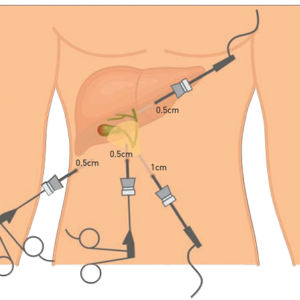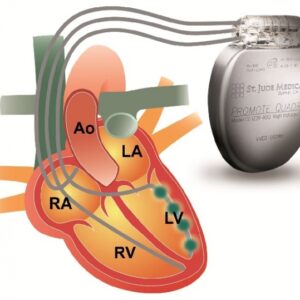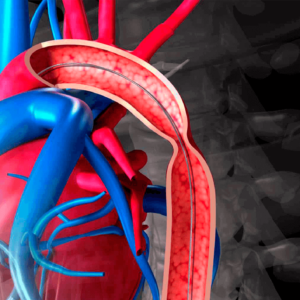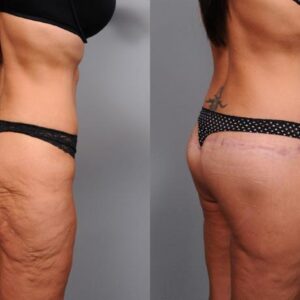Description
Familiarity with treatment
The spiral thigh lift is a surgical procedure that aims to improve the contours and appearance of the thighs by targeting multiple areas. Here is an explanation of the procedure based on the information from the search results:
Comprehensive Body Contouring: The spiral thigh lift is designed to provide comprehensive body contouring by addressing multiple areas, including the thighs, buttocks, and lateral thigh area. It combines techniques of liposuction and thigh lift surgery to achieve harmonious contours.
Incision Placement: The procedure involves making incisions along the inguinal ligament, the anterior superior iliac spine, and the lateral hip. The incisions may extend to the buttock and sacrum, depending on the patient’s specific needs and body contour.
Skin Dissection and Fixation: After making the incisions, the surgeon performs a dissection along the designated areas. In the case of the spiral thigh lift, the inferior skin flap is fixed to non-movable tissue, such as the Colles’ fascia in the medial region and the inguinal ligament in the anterior region. This fixation helps achieve the desired contour and stability.
Tissue Excision: In the medial thigh-lift portion of the procedure, the excess skin is temporarily fixed and excised in stages. The excision is performed to remove the unwanted skin and create a smoother appearance.
Scar Formation: Following the spiral thigh lift, patients can expect scars along the inside of the thigh and around the waist. Initially, the scars may appear slightly pink but will gradually change to a color slightly darker than the patient’s natural skin tone over time.
Who is it suitable for?
The spiral thigh lift is suitable for individuals who have specific concerns and goals related to their thigh and lower body appearance. Based on the information from the search results, here are some insights on who may be suitable candidates for a spiral thigh lift:
Weight Loss Patients: The spiral thigh lift is often recommended for individuals who have experienced significant weight loss, particularly after bariatric surgery or other forms of weight loss interventions. It can address excess sagging skin, skin rolls, and lumpy fat deposits that may remain after substantial weight loss.
Excess Skin and Fat: Candidates for a spiral thigh lift typically have excess skin and fat in multiple areas of the thighs, including the inner and outer thighs, as well as the front and back of the legs. The procedure aims to provide comprehensive body contouring by targeting these areas.
Desire for Harmonious Contours: Individuals who desire harmonious contours and improved thigh appearance may find the spiral thigh lift beneficial. It can help address concerns related to the overall shape, firmness, and tightness of the thighs.
Realistic Expectations: Suitable candidates for a spiral thigh lift have realistic expectations about the outcomes of the procedure. It’s important to have a clear understanding of what can be achieved through the surgery and discuss goals and expectations with the plastic surgeon.
Good General Health: Candidates for any surgical procedure, including the spiral thigh lift, should be in good general health. A thorough evaluation of the patient’s health is necessary to ensure their safety during and after the surgery.
Who is it not suitable for?
While the spiral thigh lift can be a suitable procedure for many individuals, there are certain cases where it may not be recommended. Here are some situations where the spiral thigh lift may not be suitable:
Poor General Health: Individuals with significant medical conditions or poor overall health may not be suitable candidates for the spiral thigh lift or any surgical procedure. It is important to have a thorough evaluation by a healthcare professional to determine if the surgery is safe for you.
Unrealistic Expectations: If a person has unrealistic expectations about the outcome of the procedure, it may not be suitable for them. It is important to have a clear understanding of what can be achieved through the surgery and to discuss goals and expectations with a qualified plastic surgeon.
Unstable Weight: Individuals who have not achieved a stable weight may not be suitable candidates for the spiral thigh lift. It is generally recommended that patients have reached a stable weight before undergoing body contouring procedures to ensure optimal and long-lasting results.
Active Infection or Skin Disorders: If a person has an active infection or certain skin disorders in the thigh area, the spiral thigh lift may not be suitable until the condition is resolved. Infections or skin disorders can increase the risk of complications during and after surgery.
Pregnancy or Plans for Future Pregnancy: It is generally recommended that individuals who are currently pregnant or planning to become pregnant in the near future postpone elective surgical procedures, including the spiral thigh lift. Pregnancy can significantly affect the results of the procedure.
Advantages
The spiral thigh lift offers several advantages for individuals seeking comprehensive body contouring and improvement in the appearance of their thighs. Here are some advantages of the spiral thigh lift based on the information from the search results:
Comprehensive Contouring: The spiral thigh lift targets multiple areas, including the inner and outer thighs, front and back of the legs, hips, buttocks, and even the lower abdomen. This comprehensive approach allows for a more harmonious and balanced contour of the entire thigh area.
Improved Thigh Appearance: The procedure aims to address excess skin, fat, and sagging in the thighs, resulting in slimmer, refined thighs. It can help individuals achieve a more toned and sculpted appearance.
Alternative to Traditional Thigh Lift: While a traditional thigh lift typically focuses on the inner thigh, the spiral thigh lift goes beyond that and addresses the entire thigh circumference. It offers a more extensive treatment option for individuals with concerns in multiple areas of the thighs.
Enhanced Body Proportions: The spiral thigh lift can improve the overall body proportions by addressing not only the thighs but also the buttocks and hips. This can create a more balanced and aesthetically pleasing silhouette.
Customization: The spiral thigh lift can be tailored to meet the specific needs and goals of each individual. The procedure can be combined with other techniques, such as liposuction or skin tightening, to achieve optimal results.
Suitable for Weight Loss Patients: The spiral thigh lift is often recommended for individuals who have lost a significant amount of weight, particularly after bariatric surgery or weight loss interventions. It can help address excess skin and fat that may remain after substantial weight loss, allowing patients to showcase their weight loss achievements.
Complications
Complications associated with the spiral thigh lift procedure are generally considered to be minimal, but it’s important to be aware of potential risks. Here are some insights based on the information from the search results:
Wound Healing Issues: Complications related to wound healing, such as delayed healing, poor scarring, or wound breakdown, can occur after a thigh lift procedure. Proper wound care and following postoperative instructions can help minimize these risks.
Fluid Build-up: Fluid accumulation, known as seroma, can occur after a thigh lift surgery. Surgeons may place drains during the procedure to help prevent this, and they are typically removed after a few days. However, in some cases, seromas may still develop. If this happens, additional treatment may be required, such as draining the fluid with a needle or using compression garments.
Infection: While the risk of infection is generally low, it is a potential complication after any surgical procedure. Following proper hygiene practices and taking prescribed antibiotics can help reduce the risk of infection.
Scarring: Scarring is an inevitable part of any surgical procedure, including the spiral thigh lift. The extent and visibility of scars can vary depending on individual factors and surgical techniques. However, skilled surgeons strive to place incisions in discreet locations and provide postoperative scar management instructions to optimize healing and minimize the appearance of scars.
Sensation Changes: Some individuals may experience temporary or permanent changes in sensation, such as numbness or altered sensitivity, in the thigh area after a thigh lift. These changes are typically temporary but can persist in rare cases.
Other Potential Complications: While less common, other potential complications associated with the spiral thigh lift may include blood clots, hematoma (collection of blood under the skin), asymmetry, persistent swelling, or unfavorable aesthetic outcomes. However, these complications are relatively rare.
preoperative care
Preoperative care is an essential part of preparing a patient for surgery and ensuring their safety and well-being throughout the surgical process. Here are some key aspects of preoperative care based on the information from the search results:
Assessment and Evaluation: The preoperative period begins with a comprehensive assessment and evaluation of the patient’s medical history, physical condition, and any specific risk factors. This assessment helps determine the patient’s fitness for surgery and identifies any potential complications or concerns that need to be addressed.
Medical Optimization: Preoperative care involves optimizing the patient’s medical condition to ensure the best possible outcomes. This may include managing chronic conditions, adjusting medications, and addressing any underlying health issues that could impact the surgical procedure.
Preoperative Testing: Depending on the type of surgery and the patient’s medical history, various preoperative tests and clinical assessments may be conducted. These tests can include blood work, imaging studies, electrocardiograms (ECGs), and other diagnostic procedures to assess the patient’s overall health and identify any potential risks.
Patient Education: Preoperative care includes providing patients with information about their surgical procedure, expected outcomes, and postoperative care. This education helps patients understand what to expect, alleviates anxiety, and promotes active participation in their own care.
Preparation for Anesthesia: Preoperative care involves preparing the patient for anesthesia administration. This may include fasting instructions, medication adjustments, and discussions with the anesthesiologist regarding the type of anesthesia to be used and any associated risks.
Consent and Documentation: Obtaining informed consent from the patient or their legal guardian is an important part of preoperative care. This involves explaining the procedure, potential risks and benefits, and obtaining the patient’s agreement to proceed. Documentation of the consent process and other preoperative assessments is also essential.
Postoperative care
Postoperative care is crucial for the recovery and well-being of the patient after surgery. It involves a range of measures and interventions to ensure optimal healing, manage pain, prevent complications, and support the patient’s overall recovery. Here are some key aspects of postoperative care based on the information from the search results:
Monitoring Vital Signs: Close monitoring of the patient’s vital signs, including heart rate, blood pressure, respiratory rate, and temperature, is essential in the immediate postoperative period. This helps identify any potential complications or changes in the patient’s condition.
Pain Management: Effective pain management is an important part of postoperative care. This may involve the administration of pain medications, such as opioids or non-opioid analgesics, to help alleviate discomfort and promote patient comfort.
Wound Care: Proper care of surgical incisions or wounds is essential for preventing infection and promoting healing. This may involve regular cleaning, dressing changes, and following specific instructions provided by the surgeon or healthcare team.
Mobility and Ambulation: Early mobilization and ambulation, under the guidance of healthcare professionals, can help prevent complications such as blood clots and promote a faster recovery. Patients may be encouraged to perform exercises or physical therapy to regain strength and mobility.
Monitoring and Managing Potential Complications: Postoperative care involves monitoring for potential complications, such as infection, bleeding, or adverse reactions to anesthesia or medications. Prompt identification and management of complications are crucial for the patient’s well-being.
Nutrition and Hydration: Adequate nutrition and hydration are important for the healing process. Patients may receive guidance on their dietary needs and may be provided with intravenous fluids or nutritional supplementation if necessary.
Patient Education: Providing patients with information about postoperative care, including activity restrictions, medication management, and potential signs of complications, is important. This empowers patients to actively participate in their recovery and seek timely medical attention if needed.
Follow-up Appointments: Postoperative care includes scheduling follow-up appointments with the surgeon or healthcare team to monitor progress, remove sutures or staples, and address any concerns or questions the patient may have.






Reviews
There are no reviews yet.